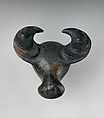Figure: Buffalo Head
Not on view
The most striking features of this buffalo head in clay are the pear-shaped head and snout as well as the wide, multi-tiered, flat horns. The distinctive black shiny surface finish of this work, as well as its zoomorphic iconography, suggest that it might come from the pottery center of Kpandu. This town of eastern Ghana, close to the Togolese border, is known for its production of globular vessels with accompanying pedestals and zoomorphic forms such as this buffalo head. The great majority of potters in Ghana are women, and Ewe potters from Kpandu are no exception.
Kpandu has been a center for ceramic since at least the 1910s, when the first examples of works in fired clay were collected by Europeans and quickly entered German museums. While it appears that many of these pieces were created to be directly sold to foreigners, some were nonetheless used by Ewe communities as food vessels or placed in shrines. The latter was probably the case for this buffalo head which demonstrates a patina that could only be the result of extensive use.
Interestingly, this work was among the twenty-three selected loans sent by the Museum of Primitive Art in New York to the First World Festival of Negro Art in Dakar, Senegal, in 1966.
Yaëlle Biro, 2016
Sources:
Biro, Yaëlle. “The Museum of Primitive Art in Africa at the Time of Independence.” In The Nelson A. Rockefeller Vision: Arts of Africa, Oceania, and the Americas. The Metropolitan Museum of Art Bulletin, Summer 2014.
Cole, Herbert M. and Doran Ross. The Arts of Ghana. Los Angeles: Museum of Cultural History, University of California, 1977, p. 62 and illustration 111 for a comparative example.
Cudjoe-Calvocoressi, Dzagbe. 1972. "A short note on terracotta animal figures from Kpandu, Volta region, Ghana,” Tribus 21, pp. 85-90.
Due to rights restrictions, this image cannot be enlarged, viewed at full screen, or downloaded.
This artwork is meant to be viewed from right to left. Scroll left to view more.




